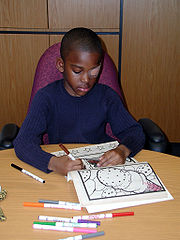
Eyepatch
Encyclopedia
An eyepatch or eye pad is a small patch that is worn in front of one eye. It may be a cloth patch attached around the head by an elastic band or by a string, or an adhesive bandage. It is often worn by people to cover a lost or injured eye, but it also has a therapeutic use in children for the treatment of amblyopia
. (See orthoptics and vision therapy
.) Eyepatches used to block light while sleeping are referred to as a sleep mask.
s who used them to cover one eye for protection from sparks while working. Sailors would also wear them over one eye above deck and then switch it over in order to be able to see in the dark below deck. David Bowie made it a fashion statement in 1972.

to the dim lighting below deck. With virtually no light sources below deck, sailors would have to rely heavily upon their eyes to adjust. In the critical moments of modifying the rigging, navigating, and especially during battle, those minutes were too precious. A simple switch of the patch from one eye to the other might have saved time when going between decks. However, this usage of the eyepatch is not supported by any historical records.
Similarly, pilots at one time would also do the same, when flying at night over brightly lit cities, so that one eye could look out, and the other would be adjusted for the dim lighting of the cockpit to read unlit instruments and maps. Some military pilots have worn a lead-lined or gold-lined eyepatch, to protect against blindness in both eyes, in the event of a nuclear blast
or laser weapon attack.
Eye patches are not currently used by military personnel; modern technology has provided an array of other means to preserve and enhance night vision, including red-light and low-level white lights, and night vision devices.
 Eye patching is used in the orthoptic management of children at risk of lazy eye (amblyopia
Eye patching is used in the orthoptic management of children at risk of lazy eye (amblyopia
), especially strabismic
or anisometropic
amblyopia. These conditions can cause visual suppression of the dissimilar images by the brain, resulting in blindness in an otherwise functional eye. By patching the good eye, the amblyopic eye is forced to function, causing vision to be retained.
) caused by an extra-ocular muscle palsy, an eye care professional
may recommend using an eyepatch. This can help to relieve the dizziness, vertigo and nausea that are associated with this form of double vision.
Amblyopia
Amblyopia, also known as lazy eye, is a disorder of the visual system that is characterized by a vision deficiency in an eye that is otherwise physically normal, or out of proportion to associated structural abnormalities of the eye...
. (See orthoptics and vision therapy
Vision therapy
Vision therapy, also known as visual training, vision training, or visual therapy, is a broad group of techniques aimed at correcting and improving binocular, oculomotor, visual processing, and perceptual disorders."-Historical development:...
.) Eyepatches used to block light while sleeping are referred to as a sleep mask.
History
In the years before advanced medicine and surgery, eyepatches were common. They were particularly prevalent among members of dangerous occupations, such as blacksmithBlacksmith
A blacksmith is a person who creates objects from wrought iron or steel by forging the metal; that is, by using tools to hammer, bend, and cut...
s who used them to cover one eye for protection from sparks while working. Sailors would also wear them over one eye above deck and then switch it over in order to be able to see in the dark below deck. David Bowie made it a fashion statement in 1972.

Sailors and pilots
It has been speculated that sailors who often went above and below deck might have used an eye patch to keep one eye adjusted to the darkness below decks. The strong sunlight while above deck on an oceangoing vessel could require minutes of adaptationAdaptation (eye)
In ocular physiology, adaptation is the ability of the eye to adjust to various levels of darkness and light.-Efficacy:The human eye can function from very dark to very bright levels of light; its sensing capabilities reach across nine orders of magnitude. This means that the brightest and the...
to the dim lighting below deck. With virtually no light sources below deck, sailors would have to rely heavily upon their eyes to adjust. In the critical moments of modifying the rigging, navigating, and especially during battle, those minutes were too precious. A simple switch of the patch from one eye to the other might have saved time when going between decks. However, this usage of the eyepatch is not supported by any historical records.
Similarly, pilots at one time would also do the same, when flying at night over brightly lit cities, so that one eye could look out, and the other would be adjusted for the dim lighting of the cockpit to read unlit instruments and maps. Some military pilots have worn a lead-lined or gold-lined eyepatch, to protect against blindness in both eyes, in the event of a nuclear blast
Effects of nuclear explosions
The energy released from a nuclear weapon detonated in the troposphere can be divided into four basic categories:*Blast—40-50% of total energy*Thermal radiation—30-50% of total energy...
or laser weapon attack.
Eye patches are not currently used by military personnel; modern technology has provided an array of other means to preserve and enhance night vision, including red-light and low-level white lights, and night vision devices.
Amblyopia

Amblyopia
Amblyopia, also known as lazy eye, is a disorder of the visual system that is characterized by a vision deficiency in an eye that is otherwise physically normal, or out of proportion to associated structural abnormalities of the eye...
), especially strabismic
Strabismus
Strabismus is a condition in which the eyes are not properly aligned with each other. It typically involves a lack of coordination between the extraocular muscles, which prevents bringing the gaze of each eye to the same point in space and preventing proper binocular vision, which may adversely...
or anisometropic
Anisometropia
Anisometropia is the condition in which the two eyes have unequal refractive power; that is, are in different states of myopia , hyperopia or in the extreme, antimetropia , the unequal refractive states cause unequal rotations thus leading to diplopia and asthenopia.Anisometropia can adversely...
amblyopia. These conditions can cause visual suppression of the dissimilar images by the brain, resulting in blindness in an otherwise functional eye. By patching the good eye, the amblyopic eye is forced to function, causing vision to be retained.
Extraocular muscle palsy
To initially relieve double vision (diplopiaDiplopia
Diplopia, commonly known as double vision, is the simultaneous perception of two images of a single object that may be displaced horizontally, vertically, or diagonally in relation to each other...
) caused by an extra-ocular muscle palsy, an eye care professional
Eye care professional
An eye care professional is an individual who provides a service related to the eyes or vision. It is a general term that can refer to any healthcare worker involved in eye care, from one with a small amount of post-secondary training to practitioners with a doctoral level of education.-Current...
may recommend using an eyepatch. This can help to relieve the dizziness, vertigo and nausea that are associated with this form of double vision.
Notable eyepatch-wearers
See also
- Orthoptist
- HaploscopeHaploscopeA haploscope is an optical device for presenting one image to one eye and another image to the other eye. The word derives from two Greek roots: haploieides, single and skopeo, to view. The word is often used interchangeably with stereoscope, but it is more general than that. A stereoscope is a...
- DiplopiaDiplopiaDiplopia, commonly known as double vision, is the simultaneous perception of two images of a single object that may be displaced horizontally, vertically, or diagonally in relation to each other...
- Binocular visionBinocular visionBinocular vision is vision in which both eyes are used together. The word binocular comes from two Latin roots, bini for double, and oculus for eye. Having two eyes confers at least four advantages over having one. First, it gives a creature a spare eye in case one is damaged. Second, it gives a...
- StereopsisStereopsisStereopsis refers to impression of depth that is perceived when a scene is viewed with both eyes by someone with normal binocular vision. Binocular viewing of a scene creates two slightly different images of the scene in the two eyes due the the eyes' different positions on the head...

